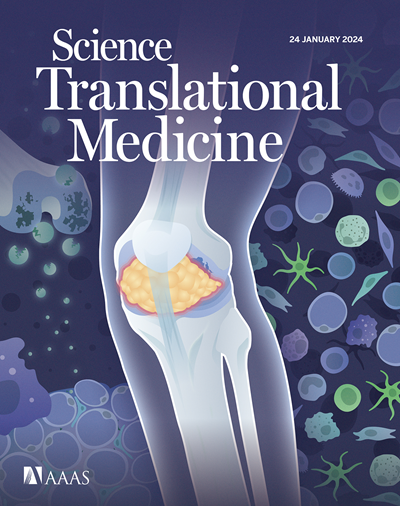Inhibiting mechanotransduction prevents scarring and yields regeneration in a large animal model
IF 15.8
1区 医学
Q1 CELL BIOLOGY
Science Translational Medicine
Pub Date : 2025-02-19
引用次数: 0
Abstract
Modulating mechanotransduction by inhibiting yes-associated protein (YAP) in mice yields wound regeneration without scarring. However, rodents are loose-skinned and fail to recapitulate key aspects of human wound repair. We sought to elucidate the effects of YAP inhibition in red Duroc pig wounds, the most human-like model of scarring. We show that one-time treatment with verteporfin, a YAP inhibitor, immediately after wounding is sufficient to prevent scarring and to drive wound regeneration in pigs. By performing single-cell RNA sequencing (scRNA-seq) on porcine wounds in conjunction with spatial proteomic analysis, we found perturbations in fibroblast dynamics with verteporfin treatment and the presence of putative pro-regenerative/profibrotic fibroblasts enriched in regenerating/scarring pig wounds, respectively. We also identified differences in enriched myeloid cell subpopulations after treatment and linked this observation to increased elaboration of interleukin-33 (IL-33) in regenerating wounds. Finally, we validated our findings in a xenograft wound model containing human neonatal foreskin engrafted onto nude mice and used scRNA-seq of human wound cells to draw parallels with fibroblast subpopulation dynamics in porcine wounds. Collectively, our findings provide support for the clinical translation of local mechanotransduction inhibitors to prevent human skin scarring, and they clarify a YAP/IL-33 signaling axis in large animal wound regeneration.
求助全文
约1分钟内获得全文
求助全文
来源期刊

Science Translational Medicine
CELL BIOLOGY-MEDICINE, RESEARCH & EXPERIMENTAL
CiteScore
26.70
自引率
1.20%
发文量
309
审稿时长
1.7 months
期刊介绍:
Science Translational Medicine is an online journal that focuses on publishing research at the intersection of science, engineering, and medicine. The goal of the journal is to promote human health by providing a platform for researchers from various disciplines to communicate their latest advancements in biomedical, translational, and clinical research.
The journal aims to address the slow translation of scientific knowledge into effective treatments and health measures. It publishes articles that fill the knowledge gaps between preclinical research and medical applications, with a focus on accelerating the translation of knowledge into new ways of preventing, diagnosing, and treating human diseases.
The scope of Science Translational Medicine includes various areas such as cardiovascular disease, immunology/vaccines, metabolism/diabetes/obesity, neuroscience/neurology/psychiatry, cancer, infectious diseases, policy, behavior, bioengineering, chemical genomics/drug discovery, imaging, applied physical sciences, medical nanotechnology, drug delivery, biomarkers, gene therapy/regenerative medicine, toxicology and pharmacokinetics, data mining, cell culture, animal and human studies, medical informatics, and other interdisciplinary approaches to medicine.
The target audience of the journal includes researchers and management in academia, government, and the biotechnology and pharmaceutical industries. It is also relevant to physician scientists, regulators, policy makers, investors, business developers, and funding agencies.
 求助内容:
求助内容: 应助结果提醒方式:
应助结果提醒方式:


